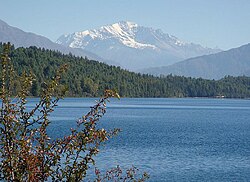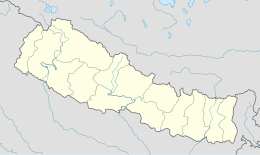Rara Lake
| Rara Lake (रारा ताल) | |
|---|---|
 |
|
| Location | Mugu District |
| Coordinates | 29°31′45″N 82°5′35″ECoordinates: 29°31′45″N 82°5′35″E |
| Type | fresh water[1] |
| Primary inflows | Karnali river |
| Primary outflows | Nijar River[1] |
| Basin countries | Nepal |
| Max. length | 5.1 km (3.2 mi) |
| Max. width | 2.7 km (1.7 mi) |
| Surface area | 1,061 ha (2,620 acres)[1] |
| Average depth | 100 m (330 ft)[1] |
| Max. depth | 167 m (548 ft) |
| Water volume | 10,682 m3 (377,200 cu ft) |
| Shore length1 | 14 km (8.7 mi) |
| Surface elevation | 2,290 m (7,510 ft) |
| 1 Shore length is not a well-defined measure. | |
Location of Rara Lake in Nepal
Contents
Features
Rara Lake lies at an altitude of 2,990 m (9,810 ft) above sea level, has a water surface of 10.8 km2 (4.2 sq mi), a maximum depth of 167 m (548 ft), is 5.1 km (3.2 mi) long and 2.7 km (1.7 mi) wide. It drains into the Mugu Karnali River via the Nijar River.[3] Its water quality is characterized by high pH, conductivity and total hardness. It was reported to be very slightly polluted and was classified as oligotrophic in limnological terms. It is polluted due to wastes produced during festivals by visiting locals and tourists.[4]Climate
Summer is quite pleasant but winter is cold. The best visiting time to the lake is September/October and April to May. From December to March, the temperatures go low below the freezing point, and heavy snowfall occur up to one meter, blocking the way to the lake. April to June is warm in this region.[5]Monsoon season, which in this region occurs between the months of July to October, is short. The average rainfall during the ten-year period 1994–2003 was 800 mm. The surface temperature of the lake was found to be 7.5 °C to 7.6 °C and was visible below 14 m to 15 m.[4]
Plant and animal life
Rara Lake, being surrounded by Rara National Park, has unique floral and faunal importance with rare and vulnerable species. The park was established in 1976 to preserve the beauty of the lake and protect it from sedimentation and adverse human activities. The Park flora consists of 1074 species, of which 16 are endemic to Nepal; the fauna includes 51 species of mammals and 214 species of birds.[6]The lake holds three endemic fish species Nepalese snowtrout (Schizothorax macrophthalmus), (S. nepalensis) and the Rara snowtrout (S. raraensis) and one endemic frog, Rara Lake frog (Nanorana rarica). Winter visitor water birds such as gadwall (Anas strepera), mallard (Anas platyrhynchos), northern shoveler (Anas clypeata), common teal (Anas crecca), tufted duck (Aythya fuligula), common golden eye (Bucephala clangula), common merganser (Mergus merganser), common coot (Fulica atra), and solitary snipe (Gallinago solitaria) reside and rest at this lake[4]
Socio-cultural and religious values
The main occupation of the people living around the area is agriculture. People also rear goats and extract medicinal herbs and sell them for their living. Thakur society is dominant in the community. Thakur Baba’s Temple is situated in the southeast corner of the lake. Local people believe that the god Thakur shot an arrow to open the passage of the lake reducing the damage caused by flooding.[3]Problems: Due to over-grazing and defecation, the national park conservation officers are facing a challenge to preserve the lake. Local people are found cutting timber wood and fuel wood, which is a problem for conservation of Rara. Also during festivals visitors and local people produce a lot of wastage causing water pollution.[3]
Tourism
Rara lake has been a popular destination with a very rough route in Western Nepal for trekkers. The glimpses of culture and scenery on the way is quite different from the rest of Nepal. Situated in high altitude, you can find the lake surrounded by Rara National Park with pine, spruce and juniper forest. The view of snow-capped Himalayan peaks enhance the attraction of trekkers. The trek begins with flight to Jumla (over an hour flight from Kathmandu) or from nearer Nepalgunj. Going along the mountain path and some villages one can reach the bank of Rara lake.[7]A travel writer describes his trek to Rara:
Although more trampled than in the past, the road to Rara Lake is still without any of the comfortable services available along more popular trails. Logistically it is not an easy trek; it is hard to get to and from, and it is an organizational challenge, requiring informed guides and porters to tote the two weeks' worth of material that will keep you warm, dry and fed. It is also tough on the bones, involving several 11,000-foot passes. However, once you overcome the obstacles, the rewards are legion: few if any other trekkers, incomparable natural splendor, "untouched" villages, blissful quiet.…[8]Rara Lake as described by GORP founder Bill Greer: "a shimmering blue jewel set in a ring of snowy peaks".[8]
Trekkers are recommended to bring their own first aid kit due to the lack of health services around the area. Since there are no accommodation facilities they may need help from a travel agency. Trekkers need to be self-sufficient as the facilities are not adequate.[5]
Rara Lake as described by Mark Drett:
"Since the interval of 10 years, I visited again. Before 10 years, we needed to walk 19 days to get there but that has been reduced to 10 hours of gravel road and 4 hours of walk. Not expected but great change. When you get there, you will get the reward for 4 hour long walk."
Rara can be the next major place for tourists to visit. During 1997–1998 the number of tourists visiting to this place was found to be 560, but in 2007 it decreased to 87 individuals. Rara Festival was conducted by the Nepal Tourism Board in early 2007 to promote domestic and international visit.[3]
Transport
Air is the only mode of transportation for the tourists visiting the Rara Lake. Rara Lake is served by Talcha Airport, which is 4 km east of the lake. Nepal Airlines and Tara Air operate flights to Rara from Nepalgunj.
Tara Air taxiing down the runway in Talcha Airport.
Photo gallery
References
- Ethan, Gelber (April 2012). "Top Ten Treks in the Nepalese Himalaya".









0 comments:
Post a Comment